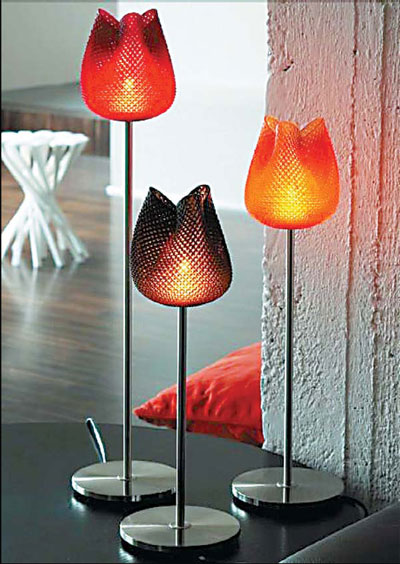3D printing reshapes manufacturing
Updated: 2013-02-18 10:48
By Wang Ying in Shanghai (China Daily)
|
|||||||||||
 |
|
Tulip table lamps, made by Materialise NV, a Belgium-based company focusing on 3D printing services, on show in Shanghai. A report on the development of 3D printing is expected to receive the central government's green light and funding support, a move that will encourage more small and medium-sized companies to enter the promising industry. Provided to China Daily |
New technology may herald a third industrial revolution, say supporters
In Jackie Chan's latest movie CZ12, also known as Chinese Zodiac, there is an eye-catching scene in which the actor uses specially made gloves to scan a bronze animal head that once crowned the famed fountain clock of the imperial retreat Yuanmingyuan Park (the Old Summer Palace). The action star then recreates the bronze head using a printing machine that operates three-dimensionally.
Although the scenario is fictional, three-dimensioned printing technology now exists and will be widely applied in many industries soon.
With modern technology, it is possible to print anything drawn on paper as three-dimensional objects. Researchers and scientists call it "additive manufacturing" but it is better known as 3D printing.
|
|
In mid-October last year, the Chinese Academy of Engineering launched research into the prospects for additive manufacturing. Many industrial experts participating in the survey will complete their first drafts in March. Final versions are expected to be submitted to the State Council by June, some involved in the survey told China Daily.
It is expected the report will receive the government's green light and funding support, which will encourage more small and medium-sized companies to enter this promising industry.
The early development of 3D printing can be traced back to the 1980s and its inventor, Chuck Hull, the US co-founder, executive vice-president and chief technology officer of 3D Systems. A few years later Chinese experts started to explore this area. Unlike traditional manufacturing based on the removal of material by cutting and drilling, 3D printing creates objects by adding layers from materials such as wax, metal and polyurethane according to virtual blueprints from computer-aided designs.
Experts are divided on the technology's future, with some asserting 3D printing will lead to a third industrial revolution.
"3D printing technology will profoundly change the traditional design and manufacturing models. So long as you have a draft, we can print anything you want according to it," said Shi Yusheng, a professor at Huazhong University of Science and Technology.
"In 1999, we printed the shell for a computer mouse using polystyrene. That was a really exciting moment," said Shi.
According to Wim Michiels, executive vice-president at Materialise NV, a Belgium-based company focusing on 3D printing services, over the past few years an increasing number of materials have been tested and put into use in 3D printing.
"This will mean a third industrial revolution, since localized production can be carried out on demand according to the requests of the customer. The customer will be less dependent on low-cost countries setting up production lines. We particularly see a lot of potential in the medical field, where customization is something that is opening doors for patients, doctors and researchers," Michiels said
However, Lin Feng, deputy director of the mechanical and engineering department at Tsinghua University, regards the new technology more as a supplement to traditional manufacturing.
"In cases in which only a couple of pieces are needed for a finished product, the advent of 3D printing will be highly efficient and economical compared with traditional manufacturing, which requires making the mold first and then starting mass production several months later. With 3D technology, the same product can be produced immediately," said Lin.
"It may be more appropriate to call it renovation rather than revolution," said Lu Bingheng, head of the mechanical and engineering department at Xi'an Jiaotong University.
Related Stories
Lucasfilm pushes pause on 3-D 'Star Wars' prequels 2013-01-29 10:11
'2012 3D' set to blow audiences' minds 2012-11-12 17:07
Dragons in 3-D 2012-08-04 07:46
Ang Lee's 3D 'Life of Pi' opens NY film festival 2012-10-01 14:54
'Frankenweenie 3D' premieres in London 2012-10-12 09:01
3-D 'Titanic' past $2 billion mark 2012-04-16 15:50
Today's Top News
Police continue manhunt for 2nd bombing suspect
H7N9 flu transmission studied
8% growth predicted for Q2
Nuke reactor gets foreign contract
First couple on Time's list of most influential
'Green' awareness levels drop in Beijing
Palace Museum spruces up
Trading channels 'need to broaden'
Hot Topics
Lunar probe , China growth forecasts, Emission rules get tougher, China seen through 'colored lens', International board,
Editor's Picks

|

|

|

|

|

|






